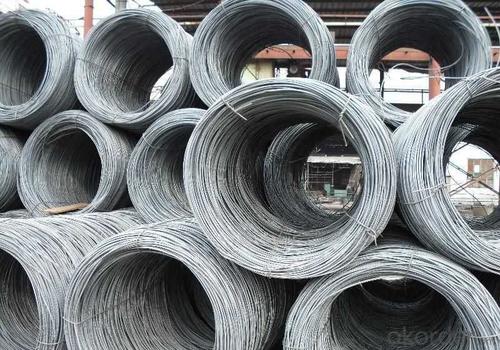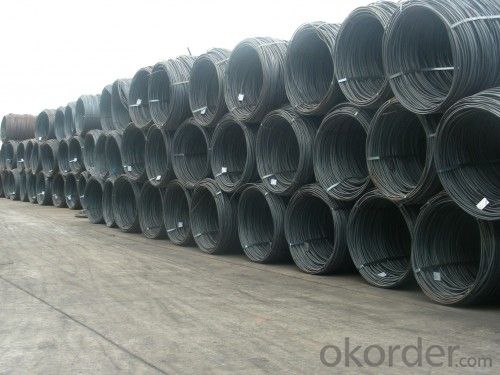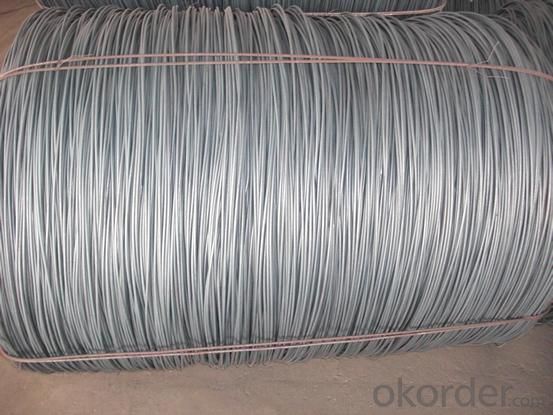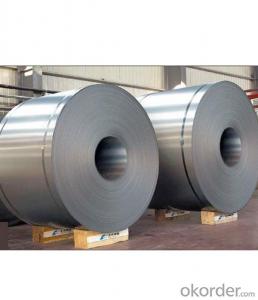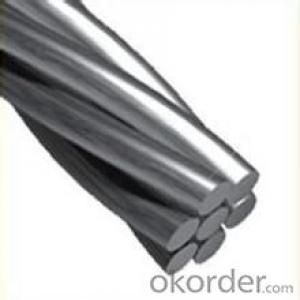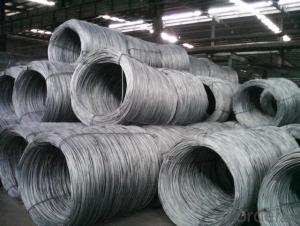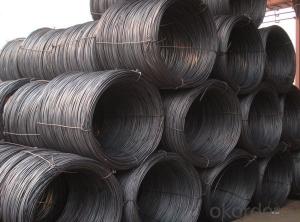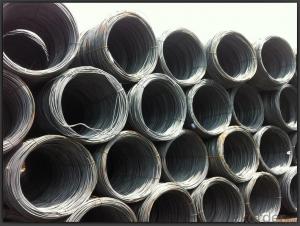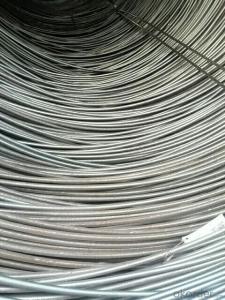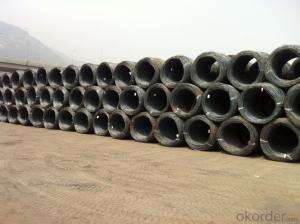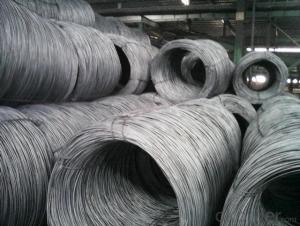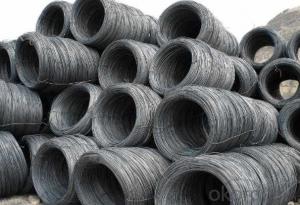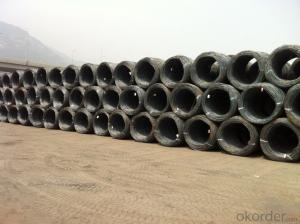Hot rolled steel wire rod 5.5mm-14mm SAE1006-1018B
- Loading Port:
- Tianjin
- Payment Terms:
- TT OR LC
- Min Order Qty:
- 25 m.t.
- Supply Capability:
- 1000000 m.t./month
OKorder Service Pledge
OKorder Financial Service
You Might Also Like
WIRE ROD Details:
| Minimum Order Quantity: | m.t. | Unit: | m.t. | Loading Port: | |
| Supply Ability: | m.t./month | Payment Terms: | TT OR LC |
Product Description:
Steel Grade: Q195 Standard: ASTM, GB
Diameter: 5.5mm, 6.5mm, 7mm,8mm,9mm,10mm,12mm,14mm
6.5mm can be drawing into 2mm/8.0mm can be drawing into 3mm
Type: Drawn Wire in Coil, each coil weight about 2MT
Brand Name: N-RIVER Place of Origin: Hebei, China
Chemical Composition:
Please kindly find our chemistry of our material based on Q195 as below for your information
Trademark | Rank | Chemical composition (quality score) % | |||||
C | Si | Mn | S | P | |||
| ≤ |
| ≤ | ≤ | |||
Q195 |
| 0.06-0.12 | 0.30 | 0.25 | 0.050 | 0.045 | |
Trademark | Rank | Pulling Test | |||||
Bend PointΔs/Mpa | Tensile Strength | Elongation Ratioδ5% | |||||
Thickness (Diameter) /MM | Thickness (Diameter) /MM | ||||||
≤16 | 16-40 | ≤16 | 16-40 | ||||
≥ | ≥ | ||||||
Q195 |
| 195 | 185 | 315-390 | 33 | 32 | |
Usage and Applications of Wire Rod Q195:
After hot-rolled the products shaped into coil and delivery as finished product, including round, square, rectangular, hexagonal and so on. Since most of the products are round, it is generally called wire rod. Carbon steel wire rod is widely used in construction and manufacturing. Carbon steel wire rod is mainly used for reinforcement of reinforced concrete and welded structure or reprocessed (roberts , nail, etc.) materials, especially used to produce wire drawing, welding electrode, nails, spring, electronic, precise machinery parts and so on
- Q: What are the common industry opportunities for steel wire rod?
- Some common industry opportunities for steel wire rod include its use in construction for reinforcing concrete, manufacturing of wire products such as fencing, nails, and cables, as well as in automotive manufacturing for components like springs and suspension parts. Additionally, steel wire rod is also utilized in the production of electrical wires and in various industrial applications like welding electrodes and wire mesh.
- Q: How are steel wire rods used in the manufacturing of tire reinforcements?
- Steel wire rods are used in the manufacturing of tire reinforcements by being embedded in rubber to enhance the strength, durability, and stability of tires. These rods provide structural support and help to resist deformation, improve traction, and increase the overall performance and safety of tires.
- Q: How is steel wire rod straightened and cut to length?
- Steel wire rod is straightened and cut to length using a process known as straightening and cutting. This process involves feeding the wire rod into a straightening machine, which helps in removing any bends or twists in the wire rod. The machine consists of a series of rollers that apply pressure on the wire rod, gradually straightening it out. Once the wire rod is straightened, it is then fed into a cutting machine that cuts the rod into desired lengths. The cutting machine consists of a blade or a cutting tool that is specifically designed to cut through the steel wire rod. The length of the wire rod is determined by setting the desired length on the cutting machine. The straightening and cutting process can be automated or done manually, depending on the scale of production. In automated systems, the wire rod is fed into the straightening machine and cutting machine through a conveyor belt or other feeding mechanisms. The length of the wire rod is set on a control panel, and the machines automatically straighten and cut the rod accordingly. Manual straightening and cutting are often used for smaller scale operations. In this case, an operator manually feeds the wire rod into the straightening machine and then manually cuts it to the desired length using a cutting tool. This process requires skill and precision to ensure accurate straightening and cutting. Overall, the straightening and cutting process is essential in producing steel wire rods of precise lengths and straightness. It is a crucial step in the manufacturing process, especially in industries such as construction, automotive, and manufacturing, where steel wire rods are utilized in various applications.
- Q: How is steel wire rod packaged for transportation?
- Steel wire rod is typically packaged for transportation in a variety of ways, depending on the specific requirements of the customer and the mode of transportation being used. One common method of packaging steel wire rod is by using coils. The wire rod is wound tightly around a central core, creating a coil that is easy to handle and transport. These coils can vary in size and weight, depending on the specific needs of the customer and the transportation method being used. Coils are often wrapped in protective materials, such as plastic or paper, to prevent damage during transportation. In addition to coils, steel wire rod can also be packaged in bundles. Bundles are typically made up of a certain number of individual rods that are securely bound together using straps or wire. This type of packaging is often used for larger quantities of wire rod, as it allows for easier handling and loading onto trucks or shipping containers. Bundles are also typically protected with some form of wrapping material to prevent damage during transportation. When it comes to shipping steel wire rod internationally, it may be necessary to use containers for transportation. In this case, the wire rod can be loaded into containers either as coils or bundles, depending on the preference of the customer and the efficiency of loading and unloading at the destination. Overall, the packaging of steel wire rod for transportation is designed to ensure the safe and efficient delivery of the product to the customer. It takes into account factors such as the quantity of wire rod being transported, the mode of transportation being used, and the specific requirements of the customer. By using coils, bundles, or containers, steel wire rod can be securely packaged for transportation, minimizing the risk of damage and ensuring the product arrives in its desired condition.
- Q: What are the main factors affecting the market collaborations of steel wire rod?
- The main factors affecting the market collaborations of steel wire rod include the demand and supply dynamics of the industry, pricing and cost structures, technological advancements, government regulations and policies, competitive landscape, and the overall economic conditions.
- Q: What are the main factors affecting the market expansion of steel wire rod?
- There are several main factors that affect the market expansion of steel wire rod. Firstly, the overall demand for steel wire rod in various industries such as construction, automotive, and manufacturing plays a crucial role in determining its market expansion. Additionally, economic conditions, including GDP growth, infrastructure development, and urbanization, greatly influence the demand for steel wire rod. The availability and cost of raw materials, such as iron ore and scrap metal, also impact the market expansion. Furthermore, technological advancements in wire rod production and manufacturing processes, as well as government regulations and policies related to trade and industry, can affect the market expansion of steel wire rod.
- Q: What are the different types of coatings for steel wire rod?
- Steel wire rods can be enhanced and safeguarded from corrosion through the application of various coatings. Some commonly employed coatings are as follows: 1. Zinc Coating: Galvanization, also known as zinc coating, is a highly favored option for steel wire rods. It ensures exceptional resistance against corrosion and can be applied using hot-dip galvanization or electroplating techniques. 2. Polymer Coating: Polymer coatings are often utilized to provide extra protection against corrosion and abrasion. These coatings can be applied through dip coating, extrusion, or powder coating methods, offering commendable adhesion and flexibility. 3. Phosphate Coating: Phosphate coatings are commonly employed as a pre-treatment for steel wire rods before the application of other coatings. They enhance the adhesion of subsequent coatings and improve corrosion resistance. 4. Epoxy Coating: Epoxy coatings are renowned for their exceptional adhesion and chemical resistance. They find frequent usage in industrial settings where the wire rods are exposed to harsh environments or corrosive substances. 5. Powder Coating: Powder coatings provide a robust and aesthetically pleasing finish to steel wire rods. These coatings are applied as dry powder and then cured under heat to create a smooth and protective layer. 6. Organic Coating: Organic coatings, such as acrylics or polyurethanes, are often employed for aesthetic purposes or to impart a specific color to the wire rods. These coatings also offer a certain degree of corrosion protection. 7. Ceramic Coating: Ceramic coatings find their application in high-temperature scenarios where the wire rods are subjected to extreme heat or thermal cycling. They exhibit excellent heat resistance and can withstand thermal shocks. It is crucial to select the appropriate coating based on the specific requirements and intended use of the steel wire rods. Different coatings provide varying levels of protection, durability, and resistance to specific environmental factors.
- Q: What are the common production processes for osmium-coated steel wire rod?
- The common production processes for osmium-coated steel wire rod include wire drawing, cleaning and degreasing, osmium coating through methods like electroplating or physical vapor deposition, and final heat treatment for improved hardness and durability.
- Q: How is steel wire rod used in the manufacturing of wire brushes?
- Steel wire rod is used as the main material in the manufacturing of wire brushes. It is typically cut into desired lengths and then twisted or coiled to create the bristle part of the brush. The steel wire rod provides durability, strength, and flexibility to the brush, allowing it to effectively clean and scrub various surfaces.
- Q: How are steel wire rods used in the manufacturing of wire ropes?
- Steel wire rods are used in the manufacturing of wire ropes as they serve as the primary raw material. These rods are drawn and twisted to form individual wires that are then helically laid around a core to create a strong and flexible rope. The high tensile strength and durability of steel wire rods make them ideal for withstanding heavy loads and providing reliable performance in various applications such as construction, mining, and lifting operations.
Send your message to us
Hot rolled steel wire rod 5.5mm-14mm SAE1006-1018B
- Loading Port:
- Tianjin
- Payment Terms:
- TT OR LC
- Min Order Qty:
- 25 m.t.
- Supply Capability:
- 1000000 m.t./month
OKorder Service Pledge
OKorder Financial Service
Similar products
Hot products
Hot Searches
Related keywords



